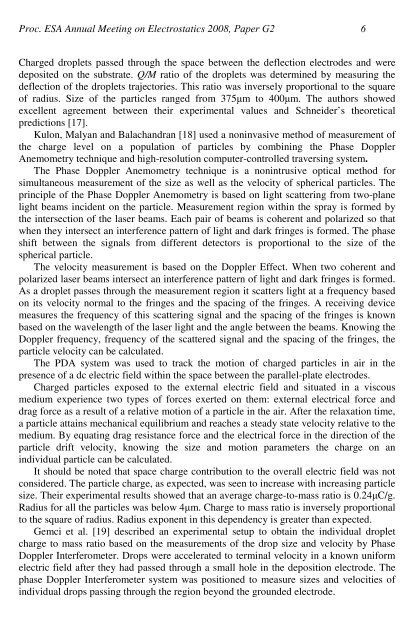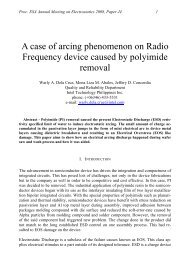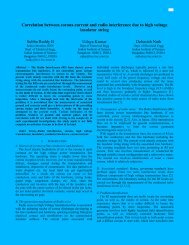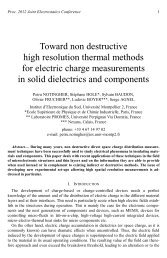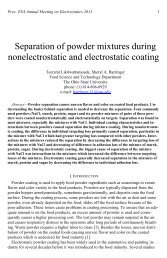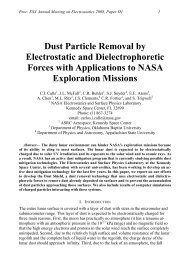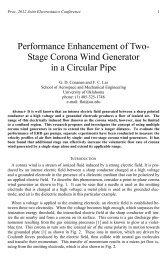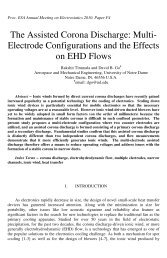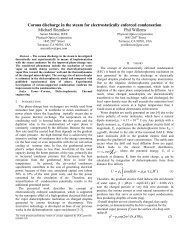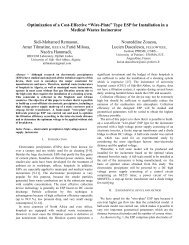Determination of Particle Charge to Mass Ratio Distribution in ...
Determination of Particle Charge to Mass Ratio Distribution in ...
Determination of Particle Charge to Mass Ratio Distribution in ...
You also want an ePaper? Increase the reach of your titles
YUMPU automatically turns print PDFs into web optimized ePapers that Google loves.
Proc. ESA Annual Meet<strong>in</strong>g on Electrostatics 2008, Paper G2 6<strong>Charge</strong>d droplets passed through the space between the deflection electrodes and weredeposited on the substrate. Q/M ratio <strong>of</strong> the droplets was determ<strong>in</strong>ed by measur<strong>in</strong>g thedeflection <strong>of</strong> the droplets trajec<strong>to</strong>ries. This ratio was <strong>in</strong>versely proportional <strong>to</strong> the square<strong>of</strong> radius. Size <strong>of</strong> the particles ranged from 375m <strong>to</strong> 400m. The authors showedexcellent agreement between their experimental values and Schneider’s theoreticalpredictions [17].Kulon, Malyan and Balachandran [18] used a non<strong>in</strong>vasive method <strong>of</strong> measurement <strong>of</strong>the charge level on a population <strong>of</strong> particles by comb<strong>in</strong><strong>in</strong>g the Phase DopplerAnemometry technique and high-resolution computer-controlled travers<strong>in</strong>g system.The Phase Doppler Anemometry technique is a non<strong>in</strong>trusive optical method forsimultaneous measurement <strong>of</strong> the size as well as the velocity <strong>of</strong> spherical particles. Thepr<strong>in</strong>ciple <strong>of</strong> the Phase Doppler Anemometry is based on light scatter<strong>in</strong>g from two-planelight beams <strong>in</strong>cident on the particle. Measurement region with<strong>in</strong> the spray is formed bythe <strong>in</strong>tersection <strong>of</strong> the laser beams. Each pair <strong>of</strong> beams is coherent and polarized so thatwhen they <strong>in</strong>tersect an <strong>in</strong>terference pattern <strong>of</strong> light and dark fr<strong>in</strong>ges is formed. The phaseshift between the signals from different detec<strong>to</strong>rs is proportional <strong>to</strong> the size <strong>of</strong> thespherical particle.The velocity measurement is based on the Doppler Effect. When two coherent andpolarized laser beams <strong>in</strong>tersect an <strong>in</strong>terference pattern <strong>of</strong> light and dark fr<strong>in</strong>ges is formed.As a droplet passes through the measurement region it scatters light at a frequency basedon its velocity normal <strong>to</strong> the fr<strong>in</strong>ges and the spac<strong>in</strong>g <strong>of</strong> the fr<strong>in</strong>ges. A receiv<strong>in</strong>g devicemeasures the frequency <strong>of</strong> this scatter<strong>in</strong>g signal and the spac<strong>in</strong>g <strong>of</strong> the fr<strong>in</strong>ges is knownbased on the wavelength <strong>of</strong> the laser light and the angle between the beams. Know<strong>in</strong>g theDoppler frequency, frequency <strong>of</strong> the scattered signal and the spac<strong>in</strong>g <strong>of</strong> the fr<strong>in</strong>ges, theparticle velocity can be calculated.The PDA system was used <strong>to</strong> track the motion <strong>of</strong> charged particles <strong>in</strong> air <strong>in</strong> thepresence <strong>of</strong> a dc electric field with<strong>in</strong> the space between the parallel-plate electrodes.<strong>Charge</strong>d particles exposed <strong>to</strong> the external electric field and situated <strong>in</strong> a viscousmedium experience two types <strong>of</strong> forces exerted on them: external electrical force anddrag force as a result <strong>of</strong> a relative motion <strong>of</strong> a particle <strong>in</strong> the air. After the relaxation time,a particle atta<strong>in</strong>s mechanical equilibrium and reaches a steady state velocity relative <strong>to</strong> themedium. By equat<strong>in</strong>g drag resistance force and the electrical force <strong>in</strong> the direction <strong>of</strong> theparticle drift velocity, know<strong>in</strong>g the size and motion parameters the charge on an<strong>in</strong>dividual particle can be calculated.It should be noted that space charge contribution <strong>to</strong> the overall electric field was notconsidered. The particle charge, as expected, was seen <strong>to</strong> <strong>in</strong>crease with <strong>in</strong>creas<strong>in</strong>g particlesize. Their experimental results showed that an average charge-<strong>to</strong>-mass ratio is 0.24C/g.Radius for all the particles was below 4m. <strong>Charge</strong> <strong>to</strong> mass ratio is <strong>in</strong>versely proportional<strong>to</strong> the square <strong>of</strong> radius. Radius exponent <strong>in</strong> this dependency is greater than expected.Gemci et al. [19] described an experimental setup <strong>to</strong> obta<strong>in</strong> the <strong>in</strong>dividual dropletcharge <strong>to</strong> mass ratio based on the measurements <strong>of</strong> the drop size and velocity by PhaseDoppler Interferometer. Drops were accelerated <strong>to</strong> term<strong>in</strong>al velocity <strong>in</strong> a known uniformelectric field after they had passed through a small hole <strong>in</strong> the deposition electrode. Thephase Doppler Interferometer system was positioned <strong>to</strong> measure sizes and velocities <strong>of</strong><strong>in</strong>dividual drops pass<strong>in</strong>g through the region beyond the grounded electrode.


